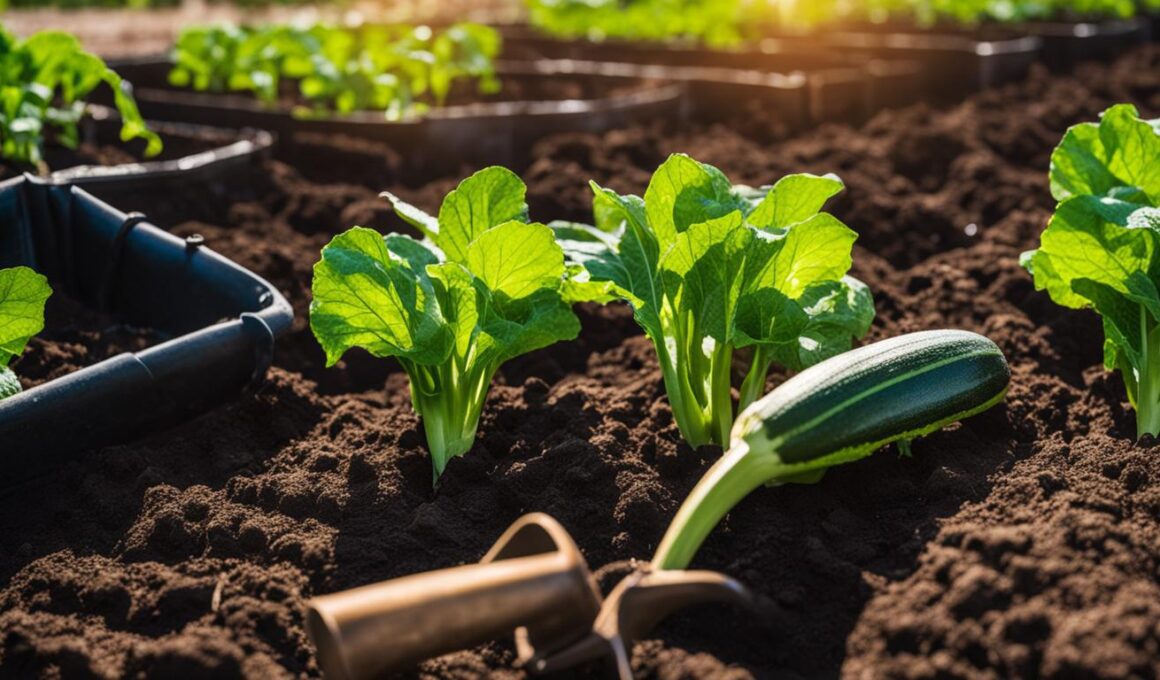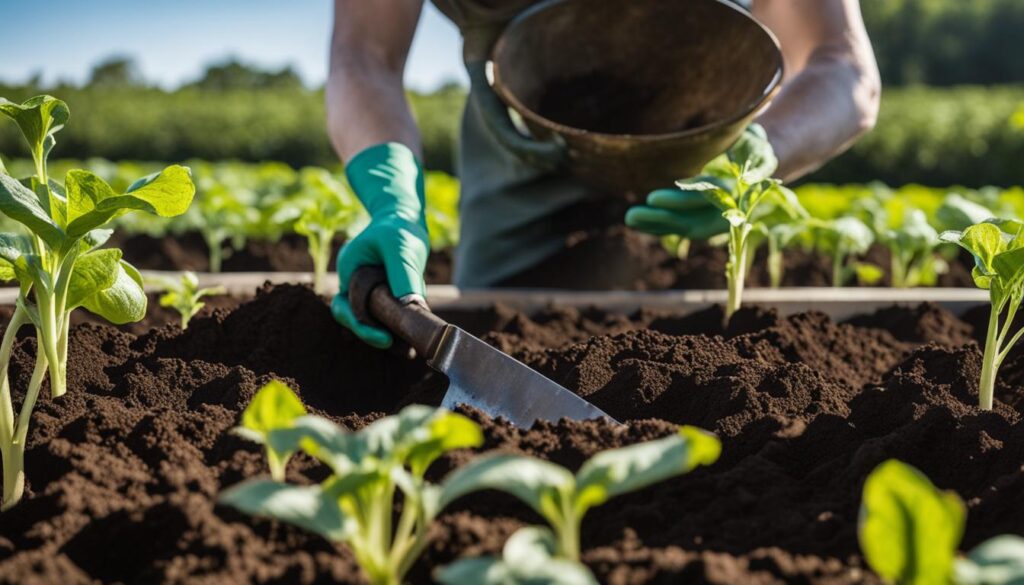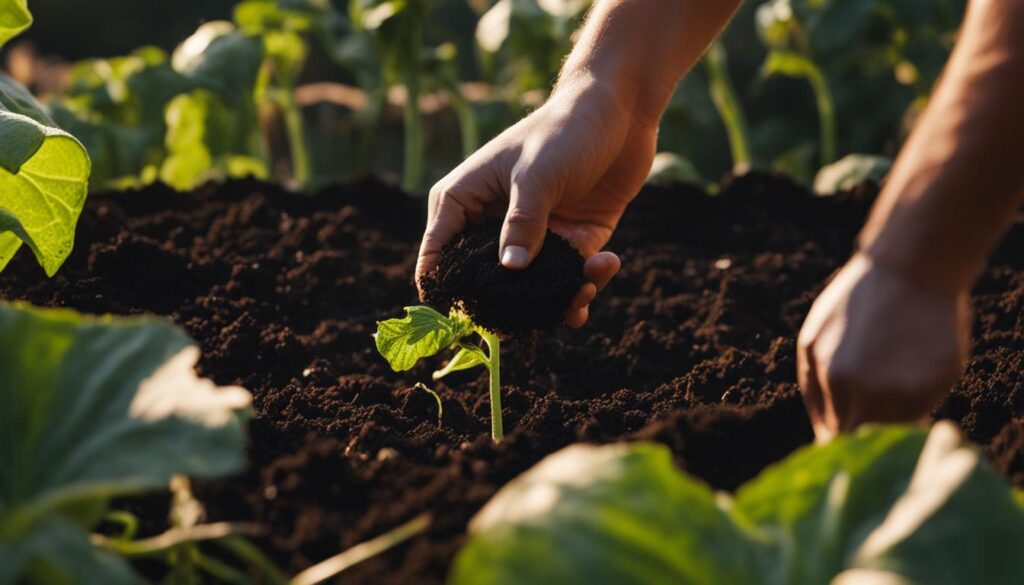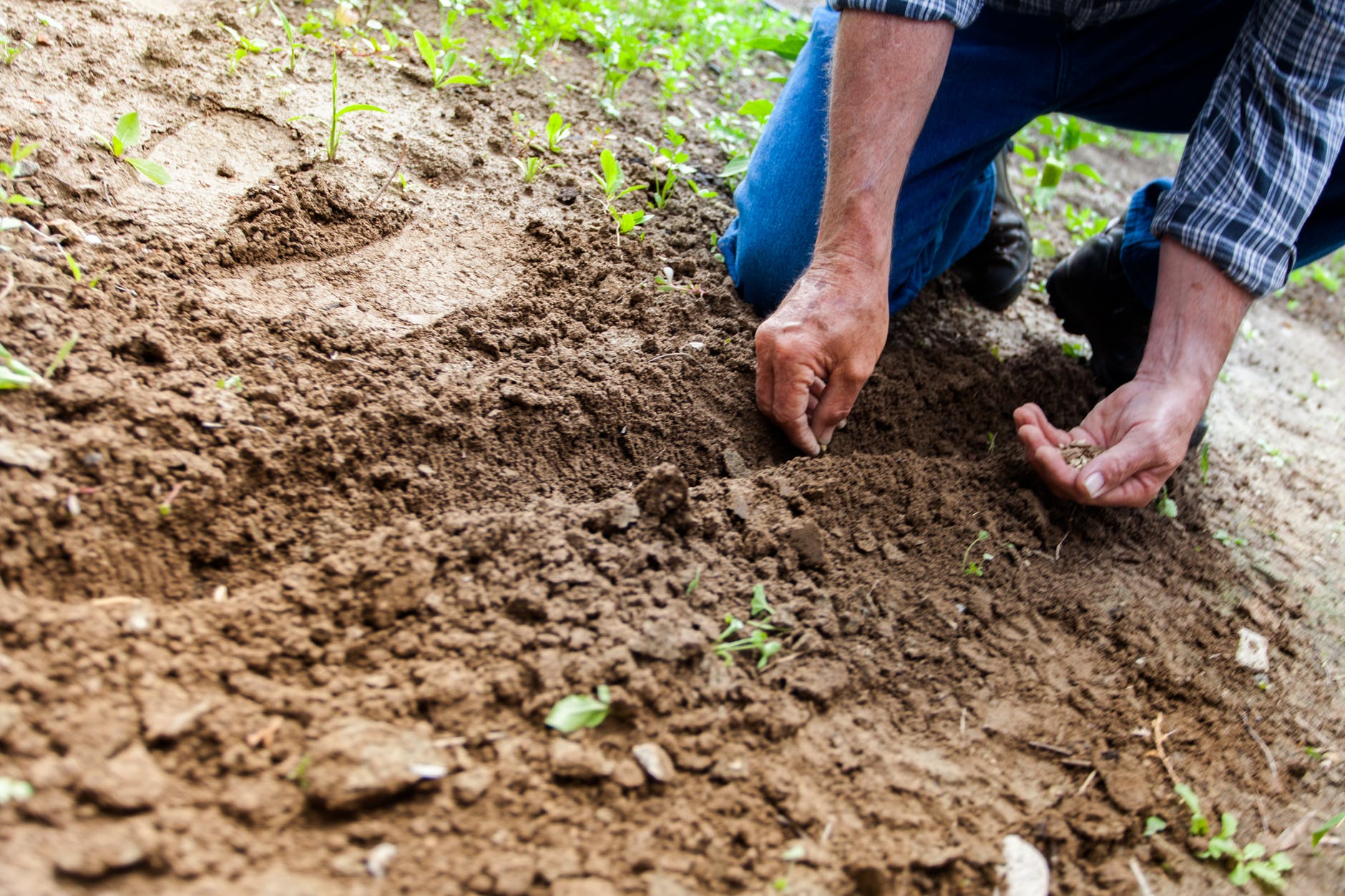If you’re looking to grow your own vegetables this season, zucchini is an excellent choice. Not only is it delicious and versatile in the kitchen, but it’s also relatively easy to cultivate. In this comprehensive guide to planting zucchini plants, you will learn the essentials of growing zucchini and discover valuable tips on how to start a successful zucchini garden.
Whether you’re a beginner or an experienced gardener, this zucchini gardening guide has something for you. From understanding the right time and method for planting, to optimizing soil conditions and dealing with common pests and diseases, you’ll find everything you need to grow a thriving zucchini garden.
Key Takeaways
- Understanding the differences between starting zucchini from seeds and seedlings
- Recognizing the importance of soil temperature and frost dates when planting zucchini
- Preparing the garden bed for optimal zucchini growth
- Nourishing your zucchini plants with the appropriate fertilizers and watering techniques
- Implementing organic controls to protect your zucchini crop from pests and diseases
- Taking advantage of efficient planting techniques for maximizing zucchini yield in small spaces
- Harvesting your zucchini plants at the right time for optimal flavor and storage
Choosing the Right Time and Method for Planting Zucchini
When it comes to planting zucchini, there are a few factors that can influence the success of your garden. The right time, method, and spacing can make all the difference in efficiently planting zucchini and maximizing your harvest.
Deciding Between Starting Zucchini from Seeds or Seedlings
Selecting whether to start zucchini from seeds or transplanting zucchini seedlings largely depends on your specific circumstances. Seeds can be planted directly in the ground, making them suitable for direct sowing. However, seedlings are more conducive to an earlier harvest, as they have already begun their growth before being transplanted into your garden.
Understanding the Importance of Soil Temperature and Frost Dates
Zucchini germination is heavily influenced by the soil temperature and frost dates. Generally, zucchini plants require soil temperatures to be above 60ºF to ensure proper growth. Always wait until the danger of frost has passed, as sudden cold temperatures can damage your zucchini plants.
Using black plastic mulch can help to warm the soil in preparation for early planting, providing the optimal conditions for your zucchini plants. Some gardeners also choose to sow a few seeds in midsummer to avoid early-season pests and diseases that can affect their crop.
Utilizing Space Efficiently with Planting Techniques
When it comes to ensuring an efficient zucchini planting and maximizing yield, it’s crucial to consider space. A space-saving zucchini garden is especially important for those who are planting zucchini in small spaces.
One method to save space is to plant zucchini using staking and pruning techniques similar to tomatoes. This allows for one plant per square foot of soil, making the most of your available space. Alternatively, you can plant seeds in level ground or small mounds, spacing rows 3 to 6 feet apart.
Here are a few ways you can plan your zucchini planting:
- Plant seeds directly in the ground after the last frost
- Use staking and pruning techniques for a space-saving approach
- Plant seeds in level ground or small mounds with adequate spacing
By carefully considering the best planting method, timing, and spacing for your zucchini plants, you can maximize your harvest and enjoy the fruits of your labor throughout the summer.
Preparing the Garden for Your Zucchini Plants
A successful zucchini garden starts with full sun, protection from wind, and soil enriched with aged manure or compost. Soil should be moist but not soggy and have good drainage. Prior to sowing seeds or transplanting, weeds should be removed, the garden area raked smooth, and a layer of 2-3 inches of compost applied on top of the soil. For enhancing soil warmth, gardeners can utilize black plastic mulch.
Follow these steps to prepare the garden and ensure the optimal environment for your zucchini plants:
- Choose a location with full sun exposure and protection from strong winds.
- Test the soil to ensure it has good drainage. If needed, amend with sand and organic matter to improve the texture.
- Enrich the soil with aged manure or compost to promote healthy plant growth.
- Remove any weeds and debris from the garden area.
- Rake the soil smooth, leveling the surface and breaking up any large clumps.
- Apply a 2-3 inch layer of compost on top of the soil to further enrich and condition the area.
- Optional: Cover the garden area with black plastic mulch to warm the soil for early planting.
Once the garden is prepared, it is essential to set up the zucchini plant bed to promote proper plant growth and development. A well-prepared plant bed ensures your zucchini plants thrive and produce a bountiful harvest.
| Zucchini Plant Bed Preparation | Benefit |
|---|---|
| Spacing | Allowing adequate spacing between plants promotes good air circulation, reducing the risk of diseases and pests. |
| Support structures | Providing support structures such as a trellis or stake can help zucchini plants grow upright, maximizing garden space and making it easier to harvest. |
| Mulching | Applying organic mulch can help maintain soil moisture, suppress weeds, and provide a barrier between the fruit and the soil to prevent rot. |
| Rotation | Rotating zucchini crops with other plants can help prevent buildup of soil-borne diseases and pests, ensuring a healthy garden ecosystem. |
With the proper garden setup and zucchini plant bed preparation, you are well on your way to cultivating a thriving and productive zucchini garden. With attention to detail and care, your zucchini plants will flourish, providing you with a delicious and abundant harvest.
Nourishing Your Zucchini Plants for Optimal Growth
Zucchini plants require proper nourishment to ensure a bountiful harvest. This includes the right type of zucchini plant fertilizer and an effective watering schedule. Here’s how to provide the best nutrition for your plants:
Feeding Your Zucchini Plants with the Right Fertilizers
Four weeks after planting, begin feeding your zucchini plants using a fertilizer designed specifically for edible plants. This provides continuous nourishment throughout the growing season, allowing for an increased yield. To better understand zucchini nutrition, consult the table below:
| Nutrient | Importance | Fertilizer Type |
|---|---|---|
| Nitrogen (N) | Essential for green, leafy growth | Organic: Aged manure, blood meal |
| Phosphorus (P) | Important for root and fruit development | Organic: Bone meal, rock phosphate |
| Potassium (K) | Strengthens cell walls, improves overall plant health | Organic: Green sand, wood ash |
Effective Watering Strategies to Prevent Common Issues
Once you’ve established a proper feeding routine, the next step is to implement an effective zucchini watering schedule to maintain plant health and prevent issues like zucchini rot. Here are some tips:
- Water zucchini plants consistently, aiming for soil moisture down to four inches.
- Ensure your plants receive at least one inch of water per week.
- Water the soil rather than the leaves to reduce the risk of disease.
- Consider using mulch to retain soil moisture and control weeds.
Following these guidelines for proper zucchini nutrition, watering schedules, and preventing zucchini rot will promote healthy growth and increase your chances of enjoying a plentiful harvest.
Mitigating Pests and Diseases to Protect Your Zucchini Crop
Your ability to manage pests and diseases is crucial in the successful cultivation of zucchini plants. This section offers insight into organic pest control methods, along with effective prevention and treatment strategies that address zucchini plant diseases.
Implementing Organic Controls for Common Zucchini Pests
Zucchini squash bugs, squash vine borers, and striped cucumber beetles are the most common pests that can afflict zucchini plants. Fortunately, there are several organic methods that can assist in managing zucchini pests:
- Using row covers to protect plants during their most vulnerable stage.
- Handpicking pests and disposing of them.
- Attracting natural predators, such as beneficial insects and birds, to help control pests.
Regular monitoring and removing eggs are also effective organic strategies. Additionally, you may redirect pest attention by using trap cropping or sacrificial plants, saving your main crop from damage.
Preventative Measures and Treatments for Zucchini Diseases
Powdery mildew and blossom-end rot are common zucchini plant diseases. It is essential to maintain consistent soil moisture to prevent these diseases. You can apply organic solutions such as a mixture of 1/3 milk to 2/3 water to control powdery mildew.
Pruning lower leaves and staking the zucchini plants enhances air circulation, reduces the likelihood of diseases, and provides easier access for bees to pollinate. Additionally, proper disease prevention for zucchini includes:
- Practicing crop rotation to minimize the risk of diseases carried over from the previous season.
- Keeping the garden area free of debris and weeds, which can harbor pests and diseases.
- Watering plants in the morning to allow the excess moisture to evaporate during the day.
What Are the Best Practices for Planting Zucchini in Oregon According to Your Guide?
When planting zucchini in Oregon, the best time to plant zucchini is in late spring or early summer when the soil temperature reaches around 60°F. Make sure to choose a sunny spot with well-drained soil and space the plants about 3 feet apart to allow for proper air circulation and growth.
Conclusion
Successful zucchini growing requires careful consideration of several key factors, starting with selecting the appropriate planting method. You’ll need to choose between direct sowing from seeds or transplanting seedlings, taking into account factors like soil temperature, frost dates, and your desired time to harvest. In order to ensure a bountiful zucchini crop, investing time in garden preparation, such as providing full sun, protection from wind, and nutrient-rich soil, is crucial.
In addition to proper environmental conditions, nurturing your zucchini plants with the right amount of nourishment and water is essential. Choose fertilizers designed for edible plants to support growth, and maintain a consistent watering schedule that keeps the soil moist but not soggy. This delicate balance can help prevent common diseases like powdery mildew, and keep pests like squash bugs and aphids at bay.
Finally, harvesting zucchini plants in a timely manner enhances their flavor and prolongs their shelf life. Harvest summer squash when slightly underripe and be sure to store them properly to maximize their viability. Exploring techniques such as staking, pruning, and container gardening can lead to more efficient and productive zucchini gardens. By implementing the tips and techniques provided in this guide, your zucchini plant care will result in a successful, bountiful harvest.











